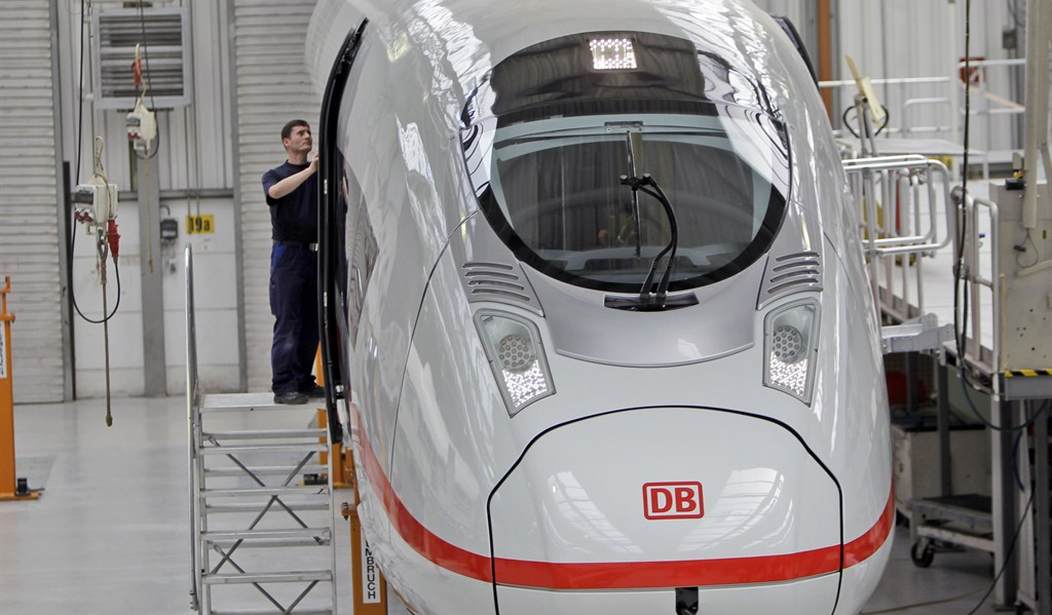California has long been infamous for its regulatory regime, imposing harsh restrictions on businesses and individuals. This pattern has been accelerating since climate change alarmism took hold in the state, with demands for carbon emission reductions serving as an excuse to restrict or ban everything from charcoal grills to gas stoves and more. Vehicles of all sorts have been swept up in this craze, with electric cars, trucks, and buses becoming the mandatory modes of transportation. Now, however, the state has its eyes on another form of transportation. Under a new proposed rule, the operation of diesel freight trains older than 23 years will be banned so they must be replaced with electric trains. That will certainly come as welcome news to climate change alarmists, but there's one small problem with this proposal. There are currently no fully electric trains in commercial production and there is no estimated timeline for when such trains might be commercially available given the current state of the technology. In other words, California is looking to mandate the use of trains that do not exist. (Institute for Energy Research)
Under a California proposed rule, starting in 2030, no diesel freight train older than 23 years may operate in the state, despite locomotives usually lasting 40 years. Half of all new trains would have to be “zero-emission” by 2030 and by 2035, all new trains must be zero-emission, even though there are no currently available electric models. The rule would essentially guarantee all train fleets would be zero-emission no later than 2058. Both the timeline for testing prototypes under development and the associated cost of an electric locomotive are uncertain.
The California regulation would mandate investments in locomotives that are not yet commercially viable while limiting the lifespans of more than 25,000 diesel-electric locomotives currently in use. The scope and financial burden of the regulation is truly mind boggling. The charging system required is also mind boggling as the batteries it must charge are big enough to power small towns. Bloomberg, normally a supporter of such gestures, opined that California’s new regulation “may break the freight railroad network.”
If this rule is approved, it could effectively destroy the railroad industry in California starting in a handful of years. The costs that would be imposed would be staggering. Perfectly serviceable locomotives would have to be pulled from service as much as 17 years ahead of their expected lifespans. Fully half of the currently operating trains would need to be retired in just six years.
So where would the replacement railroad engines come from and how much would they cost to purchase? As noted above, there is no answer to that question because those hypothetical electric trains simply do not exist. There are some hybrid diesel/electric trains being tested but they would not meet the requirements of these new regulations. One of the most obvious and daunting challenges in doing this would be the battery requirements. Most of us are already aware of the issues that have arisen regarding EV batteries in cars and trucks. The batteries are massive and functional charging stations for them remain few and far between. But one engineer studying electric train development noted that the battery required for a locomotive would have to supply enough electricity "to power a small town." You would literally have to add additional cars to the train just to haul the batteries, adding additional weight to the total load that needs to be moved.
The problem would spread far beyond the borders of California if this were done. A significant majority of the freight hauled by train travels through interstate routes. Any trains heading for destinations inside of California would need to stop before the border and switch from diesel to electric. This could take several hours because changing engines requires fresh checks of all of the compressed air brake lines. Passenger trains would no doubt become far less popular immediately.
And what sort of "climate savings" would be realized if this was done? IER reports that railroads account for only two percent of all greenhouse gas emissions from the transportation sector and just one-half of one percent of total carbon emissions. Yet the railroads handle 40% of U.S. long-distance freight volume. Even if you are a climate change fanatic, the railroads are a bargain by any reasonable method of measurement. Yet California is considering shutting them down for all intents and purposes.
Of course, the liberal legislators of California clearly don't give a flying fig about any of this. They have their agenda and they need another talking point for the next election cycle. How or if the citizens of California access the products they require on a daily basis isn't part of their formula. In that regard, the voters of California have nobody but themselves to blame. They keep electing these loons and they have to live with the results. Sadly, this is one crazy plan that will impact the entire western half of the country if it goes through.








Join the conversation as a VIP Member